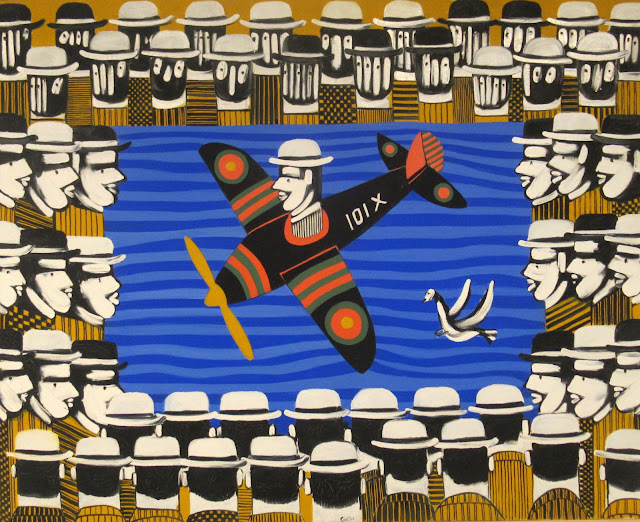The Essence of Annonymity by Yannis Gaitis
at the Theocharakis Foundation.
This is the second post on this exhibition - you can see the first one here .
In this second post I am including the introduction from the first post, plus more on the work that Gaitis is most famous for.
Born in 1923, Gaitis studied at the Athens School of Fine Arts and in 1949 he participated with Alekos Kontopoulos and other artists who had turned to abstract art, in the founding of the group The Extremists, a group which was opposed to academic art. In 1954 he went to Paris where he completed his studies. He started by painting portraits and then moved on to work that was influenced by Surrealism and Picasso. He quickly moved on to abstract expressionism and surrealist compositions, then cubist and geometric paintings and sculptures. During this stage of his work we detect the first traces of pop art's influence.
From the middle Sixties he began to make his Little People: blank-faced, uniform, anonymous, homogeneous, interchangeable. As the colonels in Greece staged their coup and set up a dictaroship, the expressionistic human profile with the hat appears in his paintings, the motif he is going to simplity and geometricalise turning it into a trade-mark of his work. This alienation in modern society was the main focus of his artistic career, the dominant and distinctive feature in his work. His style is established as pop-art. The formalistic repetition marks the painting of Gaitis from then on and up to his death. At the same petiod he paints the 'Assassination of Freedom', in which a series of soldiers shoot a pigeon.

This second post on Yannis Gaitis' work consists of the work he is most famous for, his hundreds of protagonists who we sometimes encounter on the surface of a canvas and sometimes they come out of it. They are his Little People - men without an identity usually wearing a wide-brimmed hat and carrying a briefcase. Expressionsless and stereotypical figures, always lined up in groups, usually in plaid or stripped suits
It is no coincidence that Gaitis pleaced these Little People outside, in the streets, allowing direct contact with the public, such as the encounter that occurred during his 1975 exhibition at the City Hall of Kokkinia (a working class area) where the stylised figures, along with countless colourful flags, decorated the street and the square in front of the City Hall. There, his work entered everyday life, leaving the spaces of museums.
This is Gaitis' own interpretation of pop art and his own answers to the great questions of our time. His Little People also travel to the distant past, to our ancient past, asking us to identify their ontological presence within history.

Untitled, 1968, (oil on canvas)
The Old and the Young, 1968, (oil on canvas)
Monoplane, 1968, (oil on canvas)
In the Yard of Miracles, 1966, (oil on canvas)
Human Landscape, or Contrasts, 1977, (oil on canvas)
Exhibition or Street Spectators, 1974-75, (oil on canvas)
Litany or The Red and the Black, 1977, (oil on canvas and painted wood)
looking closer at the sculpted part
The Bird, (painted wood)
looking at the sculpted part
and again
Odysseus and the Sirens, 1979-1980, (oil on canvas)
Oh! Gods, (or Symplegades), 1980, (oil on canvas)
Delos, 1979-80, (oil on canvas)
Monument and Angel, 1979-80, (oil on canvas)
Hommage to Delos, 1979-80, (oil on canvas)
You and Us, (or The Parade) 1977, (oil on canvas)
Multiple Boxes, 1971, (oil on canvas)
The sculptures in the middle of the exhibition space
Personal Transportation, 1978-79, ( painted wood and metal)
Five to Six, 1970, (painted wood)
Untitled, (painted wood)
detail






























Wow. Those human landscape are amazing.
ReplyDeleteI feel drawn by his work and the message is so powerful.
ReplyDelete